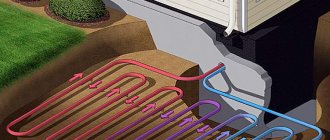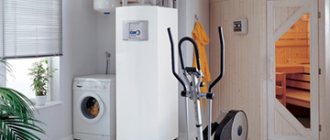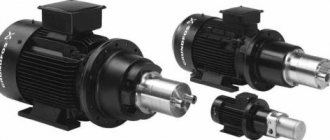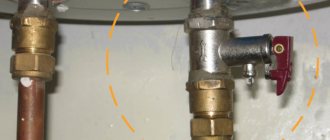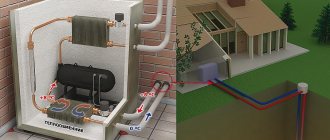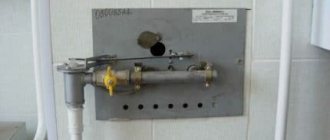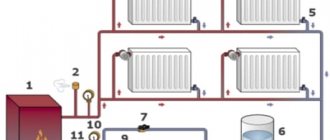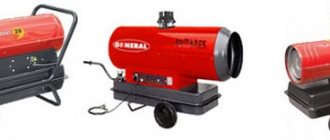- Mitsubishi Electric
- Creating a working drawing
One of the simplest and most affordable types of heat pumps is the air-to-air system, which is relatively inexpensive and easy to install and operate. Devices of this type have become widespread due to their versatility, great capabilities, and affordability. The effectiveness and reliability of air-to-air systems deserve detailed study. We discussed the operation of a water-to-water heat pump in this article, and the operation of an air-to-water heat pump in this article.
Air-to-air heat pump for home: heating in cold weather -20°C
Air-to-air systems are best known to the general user as air conditioners (more precisely, split systems). Despite the abundance of names, we are talking about the same device, the design of which is based on the use of the Carnot cycle . It describes the processes that occur during the successive evaporation of a liquid, strong compression of the resulting gas, condensation and re-formation of the liquid. During compression, the temperature of the gas increases greatly, and when the liquid evaporates, it decreases. These two phenomena are used in refrigerators, air conditioners and heat pumps, only in the first two cases the useful product is cold, and in the latter - heat.
Work principles
The basis of the air-to-air HP design is a closed circuit filled with refrigerant (freon). This circuit consists of two parts, an evaporator and a condenser. In the evaporator, liquid freon turns into a gaseous state, actively removing thermal energy from the environment. The resulting gas is fed into a compressor, where it is highly compressed, causing its temperature to rise. From the compressor, the hot gas passes into the condenser, where it changes into the liquid phase. After this, the freon is passed through the reduction valve and enters the evaporator, and the whole cycle is repeated again.
The evaporator and condenser perform the function of heat exchangers in parallel. The evaporator is supplied with an air flow taken from outside. Thermal energy is transferred to the cold freon gas, allowing it to release it upon compression. An air flow is also supplied to the condenser, but from inside the room. By blowing on the hot heat exchanger, the air gains temperature and heats the room.
Thus, to operate an air-to-air heat pump, only a closed loop with freon and two fans are required , which significantly simplifies and reduces the cost of the design compared to other types of heat pumps. If it is necessary to cool the room, then air is supplied inside from the evaporator, and the flow from the condenser is discharged outside.
Advantages and disadvantages
The advantages of air source heat pumps include:
- versatility _ The system can cool or heat the room without any modifications or complex reconfiguration
- environmental cleanliness . The system does not require hydrocarbon fuel and does not use environmentally hazardous substances.
- simplicity of design . Installing the purchased heat pump is easy
- possibility of self-production
- efficiency . Air heating quickly heats the room and has low inertia, which allows it to be cooled quickly if necessary
- economy . The cost of powering the compressor and fans pays for itself many times over
- low prices . Compared to other types of heat pumps, this option is the cheapest
- Fire safety
There are also disadvantages:
- the need to use electricity , and the system cannot tolerate power outages
- the result of work is directly related to the external air temperature , which reduces stability and forces constant adjustment of the operating mode
- constant presence of fine dust and suspended matter due to active air convection
- small but noticeable sound background when the system is operating
Air-to-air heat pumps operate until the outside temperature drops below -20°C (according to other sources, up to -10°C - depending on the specific model). After this, you have to switch to another heating system, which you must have for such situations. In Russian conditions, such dependence significantly reduces user interest, since winter temperatures in some regions are much lower.
Installation power calculation
It is not recommended to calculate the heat pump yourself. It is necessary to use a lot of special data, coefficients and other values that only specialists can use. If you need to calculate the system, you need to contact professionals. They have the experience and knowledge that is necessary in this matter.
Work at -20°C
Pros and cons of the design
The advantages of this type of installation include the following features:
- Environmentally friendly. Their operation is completely unrelated to the release of any pollutants into the atmosphere.
- Inexpensive to install. The installation of heat pumps, although it requires qualifications, is generally not very complicated, which has a positive effect on the price of the work.
- They do not pose a fire hazard. The use of such systems is absolutely safe from the point of view of fire, unlike the same fireplaces.
- Economical. The energy costs required for the operation of the units are insignificant, which allows you to save on heating your home.
- Easy to maintain. You can also service air-to-air heat pumps yourself if you follow the simple instructions. However, these units also have a number of disadvantages:
- The operation of the forced air injection system and compressor is associated with noise exposure, albeit small.
- Dependence on external climatic conditions.
- Dust coming from the street along with the forced air.
- The need for continuous power supply.
Thus, the use of air-to-air heat pumps is the best option for economical space heating. True, a number of factors, for example, weather conditions and thermal insulation of the house, impose significant restrictions on the use of these units.
What to buy? Top 5 best pump manufacturers
The choice of an air-to-air heat pump is made based on the area of the house, ceiling height, material and other parameters. The main value on the basis of which the choice is made is the heated area, since the power of the heat pump depends on its size. The remaining indicators are clarifying; they must be taken into account when choosing in order to avoid mistakes.
Specific models can only be recommended for a specific home. In order to guide the user, we can only recommend the most reliable manufacturers. Let's consider the most popular companies engaged in the manufacture of air-to-air heat pumps:
Mitsubishi Electric
The company is a recognized leader among manufacturers of air source heat pumps
Fujitsu General LTD
Particularly notable is the GENERAL NORDIC series, consisting of a wide range of heat pump models for rooms of different sizes
NIBE
A Swedish company with a strong position in the European market for heat pump manufacturers. It features a successful combination of quality and cost of equipment
Danfoss
A company from Denmark, a country where the use of air heat pumps is very widespread
Vitocal
A German company that maintains traditions of quality, precision and reliability of equipment
The most reputable companies whose products do not require special advertising are considered. At the same time, the number of manufacturers is very large. For buyers with limited financial resources, products from Chinese or Taiwanese companies may be useful. A significant share of the market is occupied by products of Russian companies, which set more affordable prices than European companies.
How to calculate equipment power
A small amount of heat is present in the air space even when the temperature drops to -20 degrees Celsius. It is important that it is suitable for heating a house using an autonomous design. Special software is usually used to calculate the required parameters. You can use online systems that have fields for entering numerical values. They can indicate the area of the room and the height of the ceilings. Sometimes it is possible to set a temperature range specific to the region.
The heat pump can operate even in severe frosts, but it will work with less efficiency. The temperature range from -10 to +10 degrees Celsius is favorable for the system. In order not to make a mistake when choosing a pump, it is worth considering the following factors:
- refrigerant volume;
- total surface area of the coils in the external and internal blocks;
- planned volume of heat transfer.
Since the system has a relatively simple design, even a technician with little experience in handling equipment can install it. But it is advisable to entrust the calculations to specialists. At a minimum, they should be consulted. Experts will help you determine the required coefficients and calculate the air-to-air heat pump taking into account all factors. In central Russia, for a house with an area of 100 square meters, a unit with a capacity of 5 kilowatts is enough.
Installation cost
Installing an air source heat pump is not particularly difficult , so most users do it themselves. You only have to contact a special service center if you purchase expensive models from well-known European manufacturers, who refuse warranty service if the installation was not carried out by their specialists. In such situations, you have to pay quite significant amounts for installation, although the prices are different for everyone and largely depend on the region. In other cases, installation is carried out independently, which requires virtually no costs.
Differences between an air heat pump and an air conditioner
A heat air pump operates in many ways similar to an air conditioner, but has some distinct features. Let's look at them in more detail:
- The main advantage of a pump over an air conditioner is efficiency. Air conditioners spend significantly more electricity to operate, and when switching to heating mode, costs increase.
- The heat pump has high performance and heats the room as much as possible. And some types can cool the room. But during cooling, the efficiency of pumps is significantly inferior to air conditioners.
- Application area. Heat pumps are used to heat rooms throughout the year. And some models can cool. Air conditioners work as ventilation and can additionally heat the room, but taking into account the fact that the air temperature is more than +5 C.
How to make an air-to-air heat pump with your own hands
High prices for the purchase and service of heat pumps encourage users to make devices with the required parameters with their own hands. To do this, you need to have certain skills and knowledge, but for trained people such a task does not pose significant difficulties.
The procedure consists of three stages:
- preparation, acquisition of all materials, parts or finished structural units
- heat pump assembly
- launch, setup
Creating a working drawing
The first stage is required in order to acquire all the necessary materials, but the main task is to create a working drawing. It is necessary to carefully consider the design and methods of connecting all components and parts, provide for ease of maintenance and repair, and other operating issues. Experienced craftsmen recommend starting work only after all unclear points have been clarified, so as not to act at random.
Pump assembly
The second stage is the actual creation of the heat pump. Its design consists of two heat exchangers of almost identical design, the only difference is in the sizes of the coils. To create coils, a copper tube is used, which is wound onto a pipe or any cylindrical mandrel. The coils are installed in casings that are blown through by fans. This results in two heat exchangers operating on the principle of a heater.
- One of them (the evaporator) is blown with outside air, which releases thermal energy.
- The second is a condenser; hot freon passes through it.
When blown by a flow of air, a warm flow is created that enters the living quarters.
A compressor is installed between the evaporator outlet and the condenser inlet. The condenser outlet and the evaporator input are connected by a throttle, which provides a pressure drop across the evaporator. If you have no experience in creating refrigeration systems, you should contact a professional in this matter.
Installation of such systems requires experience and skills so as not to miss important points that ensure stable and uninterrupted operation of the system. You will need to install shut-off valves, valves and other elements that are necessary for filling the system with freon, inspection, maintenance and other work.
Launch
The third stage consists of a trial run, performance testing and system configuration . It is recommended to install a control unit (a unit from an air conditioner will do) that allows you to regulate the operation of the system during operation. All elements of the heat pump should be hidden in casings or housings that protect the system from mechanical damage and, in particular, from icing.
the housing of the outdoor unit and equip it with a defrosting system , since condensate accumulating on the evaporator coil cuts off the air flow and reduces the efficiency of the blower.
Service
System maintenance must be performed regularly. It is necessary to remove dust and inspect connections, especially joints of pipes, fittings and other elements. It is necessary to monitor the condition of the fans, lubricate them on time and clean the blades from dust so that the air flow does not carry a fine suspension of solid particles and dust into the living room.
